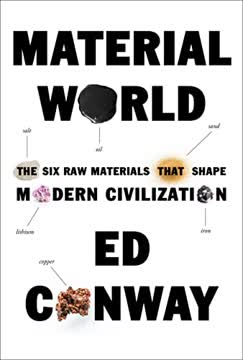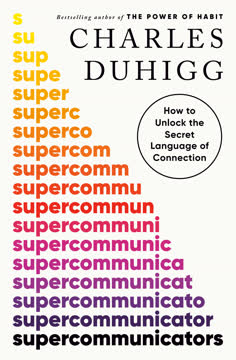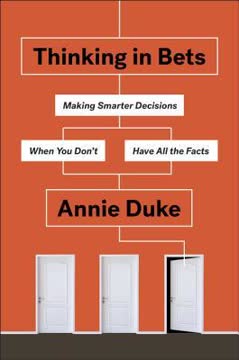Key Takeaways
1. Embrace Uncertainty: Probabilistic Thinking is Key
The only certainty is that nothing is certain.
Navigating Complexity. In a world marked by increasing complexity and uncertainty, the ability to make sound decisions is more critical than ever. The most formative preparation for this is not specific training in finance or economics, but rather the cultivation of a philosophical mindset that embraces uncertainty as a fundamental condition.
Probabilistic Thinking. The core of this approach lies in "probabilistic thinking," which acknowledges that absolute certainty is unattainable. Instead, views and decisions should be framed in terms of probabilities, considering various possible outcomes and their likelihood. This involves assessing trade-offs and choosing the path most likely to yield the best result, rather than seeking an elusive "right" answer.
The Yellow Pad Method. A practical tool for probabilistic thinking is the "yellow pad" method, where potential outcomes are listed alongside their estimated probabilities. This method encourages a rigorous evaluation of costs and benefits, both quantifiable and non-quantifiable, and provides a framework for balancing conflicting beliefs and priorities.
2. Reacting vs. Responding: Thoughtful Decisions in Disruptive Times
We shouldn’t react. We should respond.
Extreme Disruption. Moments of "extreme disruption," characterized by rapid and dramatic changes, often lead to poor decisions. In these situations, relying solely on experience can be misleading, as the context has fundamentally shifted. The key is to avoid impulsive reactions and instead engage in thoughtful analysis.
Responding with Discipline. Responding involves stepping back, considering potential consequences, and making choices based on a careful evaluation of costs and benefits. This requires discipline and the ability to manage emotions, rather than being overwhelmed by them. Strong leaders understand their emotional biases and compensate for them.
Harnessing Group Wisdom. Decision-makers can also benefit from harnessing the power of a group, seeking diverse viewpoints and encouraging disagreement. This helps to identify potential opportunities and challenges that might otherwise be overlooked, while also mitigating individual biases. However, the ultimate responsibility for the decision rests with the leader, who must be willing to make the final call based on their best judgment.
3. Risk as a Range: Beyond Single-Point Estimates
Risk is a range.
Beyond Single Numbers. Traditional approaches to risk often rely on single-point estimates, which can be misleading and dangerous. Risk should instead be understood as a range of possibilities, acknowledging the inherent uncertainty in any decision. This involves considering both the most likely outcome (base case) and the potential for extreme events (tail risk).
Understanding Tail Risk. Tail risks, while having low probabilities, can have catastrophic consequences. It is crucial to assess the likelihood and potential impact of these events, rather than dismissing them as negligible. The difference between a thin tail and a fat tail matters significantly, especially when the potential consequences are dire.
The Yellow Pad for Risk. The yellow pad method can be used to evaluate the full range of risk, by listing potential outcomes and assigning probabilities to each. This forces decision-makers to grapple with difficult questions, such as how to estimate probabilities, consider trade-offs, and deal with non-quantifiable factors. The goal is not to eliminate risk, but to manage it effectively by making informed judgments based on the best available information.
4. The Human Factor: Wiring, Luck, and Personal Traits
Each of us is more than the worst thing we’ve ever done.
Beyond Merit Alone. While talent and hard work are essential, luck plays a significant role in shaping one's life trajectory. This includes both avoiding bad luck (illness, accidents) and benefiting from good luck (favorable circumstances, opportunities). Recognizing the role of luck fosters appreciation and humility.
The Importance of Wiring. "Wiring" refers to the innate traits and psychological characteristics that influence how individuals approach challenges and make decisions. This includes factors such as intensity, mental toughness, energetic curiosity, being true to oneself, and professional integrity.
Cultivating Key Traits. While some aspects of wiring may be innate, individuals can cultivate certain traits that contribute to success. This includes developing intensity in pursuing goals, maintaining mental toughness in the face of stress, fostering energetic curiosity, and acting with integrity. These qualities can help individuals navigate the complexities of life and make sound decisions.
5. Embracing Human Complexity: The Art of Management
You work for the people who work for you.
Beyond Rules and Dogma. Effective management goes beyond applying a set of rules or following a specific management theory. It requires embracing the complexity of individuals, recognizing their unique strengths, weaknesses, and motivations. This involves tailoring management approaches to each person, rather than treating all employees the same way.
Valuing Individual Contributions. Managers should focus on each individual's overall contribution to the organization's long-term success. This may involve tolerating some eccentricities or difficult behaviors from highly talented individuals, while also making difficult decisions about those who are well-liked but underperforming. The key is to prioritize the organization's goals while fostering a supportive and inclusive environment.
Culture and Leadership. Leaders play a crucial role in shaping an organization's culture, which should be based on their personal values and beliefs. This involves setting clear expectations, distributing credit and blame fairly, and fostering a sense of responsibility and collaboration. A strong culture can help to attract and retain top talent, while also promoting ethical behavior and long-term success.
6. Applied Existentialism: Managing Crises with Perspective
This is highly important right now, but 100,000 years from now, none of it will matter.
Self-Management in Crisis. In times of crisis, it is essential to manage oneself effectively. This involves controlling fear and anxiety, maintaining a clear head, and avoiding both irrational optimism and pessimism. Techniques such as compartmentalization, breaking down challenges into smaller tasks, and maintaining perspective can be helpful.
Applied Existentialism. "Applied existentialism" involves recognizing the importance of one's work while also acknowledging its limited significance in the grand scheme of things. This can provide a sense of perspective and help to avoid being overwhelmed by stress.
Strategic Communication. Effective crisis management also requires clear and honest communication with stakeholders, including employees, clients, and the media. This involves being truthful while also projecting a sense of stability and confidence. It is also important to designate a crisis-management team and allow others to focus on their regular duties.
7. Learning from Mistakes: Ex Ante vs. Ex Post Evaluation
The best managers do the opposite.
Beyond Outcome-Driven Analysis. Evaluating decisions solely based on outcomes can be misleading. It is crucial to consider the soundness of the decision-making process, including the information available at the time, the analysis that was conducted, and the judgments of probabilities that were made. This involves distinguishing between being "right" for the wrong reasons and being "wrong" for the right reasons.
Ex Ante vs. Ex Post. An "ex ante" approach focuses on evaluating decisions based on the information available at the time, while an "ex post" approach focuses on the outcome. A rigorous evaluation process should incorporate both perspectives, but with a greater emphasis on the ex ante analysis.
The Importance of Intellectual Honesty. Evaluating past decisions requires intellectual honesty and a willingness to acknowledge both successes and failures. This involves avoiding the temptation to take credit for positive outcomes that were due to luck, and also avoiding the temptation to blame others for negative outcomes that were the result of sound decision-making.
8. Unfettered Discussion: The Power of Open Exchange
Our major policy obligation is not to mistake slogans for solutions.
The Value of Openness. Individuals, organizations, and societies that permit, protect, and encourage the open exchange of views make better decisions than those that do not. This involves creating an environment where people feel comfortable expressing their opinions, even if those opinions are unpopular or challenge the status quo.
Creating a Culture of Respect. Fostering unfettered discussion requires mutual respect and a presumption of good faith. This means treating others considerately, giving them the benefit of the doubt, and being open to hearing their perspectives, even when they differ from one's own.
Challenging Assumptions. Unfettered discussion also involves challenging assumptions and encouraging intellectual curiosity. This means being willing to ask difficult questions, acknowledge gaps in knowledge, and seek out diverse viewpoints. It also means being wary of chilling effects that might discourage people from expressing their opinions.
9. Principled Compromise: The Art of Effective Governance
Not everything is the Alamo.
Beyond Inviolable Principles. While principles are important, an overreliance on inviolable principles can hinder effective governance. The ability to compromise, to engage in give-and-take, is essential for addressing complex challenges and moving forward in the face of disagreement.
Balancing Politics and Policy. Effective governance requires a balance between politics and policy. Politicians must be willing to make politically difficult decisions in order to advance the common good, while also recognizing the need to be reelected. This involves finding ways to make the benefits of politically difficult decisions resonate with people.
Structural Reforms. Structural reforms to the political process, such as campaign finance reform and the reinstatement of earmarks, can help to realign incentives and promote more effective governance. However, these reforms must be carefully designed to avoid unintended consequences.
10. Labels are Limiting: Thoughtful Analysis Beyond Ideology
Labels Are No Substitute for Thought
Beyond Partisan Divides. Policy debates often rely too heavily on partisan or ideological labels, which can simplify complex questions and hinder thoughtful analysis. It is important to move beyond these labels and engage with the facts and evidence, regardless of one's political affiliation.
The Importance of Intellectual Integrity. Intellectual integrity is crucial for sound policy-making. This involves being honest about the evidence, even when it contradicts one's own views, and being willing to change one's mind in light of new information.
The Role of the Media. The media plays a critical role in shaping public opinion and holding politicians accountable. However, the rise of cable TV and social media has created an environment where misinformation can spread easily and politicians can bypass traditional sources of accountability.
11. Foundational Questions: Challenging Assumptions for Clarity
What do we mean by ‘city’?
Going Below the Surface. In addition to engaging with facts and analysis, it is also important to ask foundational questions that challenge underlying assumptions. These questions can help to broaden and deepen a conversation, while also revealing hidden biases and potential pitfalls.
The Nature of Foundational Questions. Foundational questions are not always necessary, but when they are important, they are crucial to the decision-making process. These questions tend to involve concepts rather than specifics, and they should be asked seriously and in a spirit of genuine inquiry.
Examples of Foundational Questions. Examples of foundational questions include: What is a city? What are human rights? What role should corporations serve in society? What is democracy? By engaging with these questions, decision-makers can gain a deeper understanding of the issues at hand and make more informed choices.
12. The Case for Engagement: Navigating Uncertainty with Action
Sound judgment is more desperately needed than ever.
The Importance of Engagement. In the face of increasing uncertainty and complexity, it is easy to become discouraged or to retreat into simplistic answers. However, it is more important than ever to engage with the world and to try to make a positive difference.
The Power of Action. While the challenges we face may seem overwhelming, we should not allow ourselves to be paralyzed by fear or doubt. Instead, we should focus on taking action, making the best decisions we can with the information available, and working to create a better future.
A Call to Action. The future of our society, our democracy, our economy, and our planet depends on our willingness to engage thoughtfully and constructively with the challenges we face. This requires a commitment to probabilistic thinking, intellectual honesty, and principled compromise. It also requires a willingness to embrace uncertainty and to act with courage and conviction.
Last updated:
Review Summary
The Yellow Pad receives mixed reviews, with an average rating of 3.73 out of 5. Readers appreciate Rubin's insights on decision-making, particularly his probabilistic approach. Many find the book intellectually stimulating and value its blend of personal anecdotes from high-level business and government experiences. However, some critics find it dry or repetitive, and note that it's more of a memoir than a practical guide. The book's discussions on policy, economics, and leadership are generally well-received, though opinions vary on its overall effectiveness and readability.
Similar Books










Download PDF
Download EPUB
.epub digital book format is ideal for reading ebooks on phones, tablets, and e-readers.





